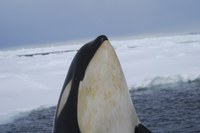From Antarctica to New Zealand: ten killer whales tagged with satellite transmitters to track the long journey
For the first time, the satellite tracking, carried out by the Italian base in Antarctica on ten specimens of killer whales, allowed to follow their movements along the pack, in order to study their movements in the medium to long term, the diving behavior and consequently eating habits. This study aimed to investigate killer whales movements in the Antarctic ecosystem, led by ISPRA in cooperation with the Institute Tethys under the National Programme of Antarctic Research (PNRA), which is ended last February 11.
Starting from the Italian base in Antarctica "Mario Zucchelli" and
using the available information on the presence of killer whales collected in the 2004 campaign, the pack's edge was inspected by researchers to identify groups of animals, thanks to helicopters. Once spotted specimens, we proceeded with the video shooting, the study of the behavior and the definition of group size and age classes of the specimens. Subsequently, when the pack's conditions allowed, we landed in an area next to the crossing point of the group for the photographic identification, the removal of skin biopsy for genetic and toxicological analysis (carried out by the University of Siena) and the application of satellite transmitters.
One of the two groups of killer whales with satellite transmitter, made up of 8 speciments, have stayed for over a week a few miles from the Italian base, between the Campbell Glacier and Cape Washington. This area is particularly important for the silverfish, the main prey of this type of Orca, which is known as fisheating (predator of fish) and is also known with the name of type C orca or of the Ross Sea orca. It seems therefore that the animals, before a possible long journey towards north, have made food stocks here.
After staying in the Newfoundland Bay, the specimens have begun to migrate to New Zealand and, after passing the island, it seems they are coming back again to the low latitudes.
The same path is followed by other two specimens marked in a second group, also close to the Italian Antarctic base. After a period spent on the coast of the Ross Sea, they moved towards New Zealand, following the same path of the first group of specimens.
The study was realized in collaborations with American researchers at the National Oceanic and Atmospheric Administration (NOAA) and is part of a broad research program on cetaceans in the southern ocean (Southern Ocean Research Program - SORP) within the
International Whaling Commission (IWC).
ISPRA provides photos and video of the activities conducted in
Antarctica.

